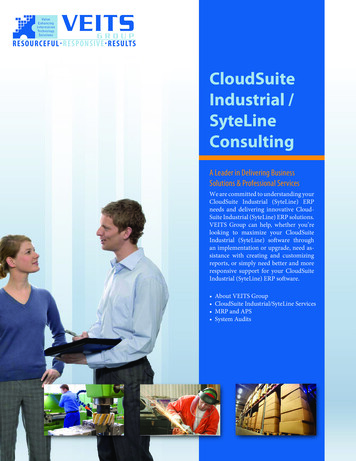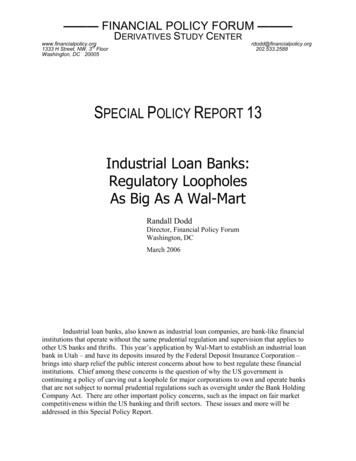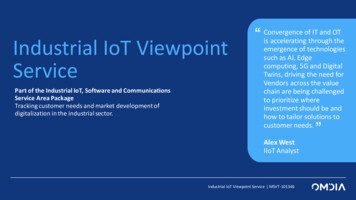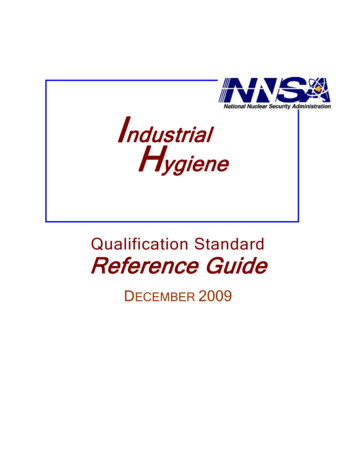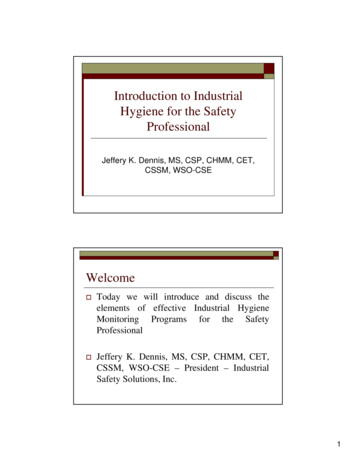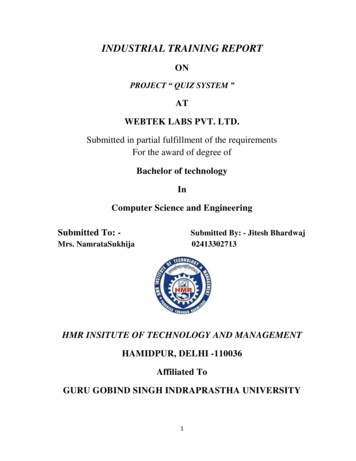
Transcription
INDUSTRIAL TRAINING REPORTONPROJECT “ QUIZ SYSTEM ”ATWEBTEK LABS PVT. LTD.Submitted in partial fulfillment of the requirementsFor the award of degree ofBachelor of technologyInComputer Science and EngineeringSubmitted To: -Submitted By: - Jitesh Bhardwaj02413302713Mrs. NamrataSukhijaHMR INSITUTE OF TECHNOLOGY AND MANAGEMENTHAMIDPUR, DELHI -110036Affiliated ToGURU GOBIND SINGH INDRAPRASTHA UNIVERSITY1
DECLARATIONI, JITESH BHARDWAJ , Student of Btech (CSE) declare that the project titled“QUIZ SYSTEM ” which is submitted by me to Department of computer scienceand engineering, HMR INSTITUTE OF TECHNOLOGY AND MANAGEMENT,HAMIDPUR DELHI affiliated to Guru Gobind Singh Indraprastha University.Date: 17TH OCT 2016JITESH BHARDWAJ2
ACKNOWLEDGEMENTThe successful completion of this project mark the beginning of an ever - goinglearning experience of converting ideas and concepts into real life, practicalsystem. This project was a quite a learning experience for me at each and everystep. At the same time it has given me confidence to work in professional setup.I feel the experience gained during the project will lead me to gain the brightprospect in the future. First of all I would like to give thanks to Head,Education and Training, Mr. Altaf, for giving me the opportunity to work inthis esteemed organization, which not only has increased our awareness aboutlatest fields but also taught me the importance of team building. With the deepsense of gratitude, I express my sincere thanks to Ms. Swati Sethi, for her activesupport and continuous guidance without which it would have been difficult forme to complete this project. I will also like to the other working staff teachersat WEBTEK LIMITED for taking keen interest in my project and givingvaluable suggestions and helping me directly or indirectly to complete thisproject.JITESH BHARDWAJ02413302713Btech (CSE)3
CERTIFICATE4
ABSTRACTThis project “ QUIZ SYSTEM ” aims to provide interactive platform to the studentsto learn and grow. This software will help students in accessing their learning andimplementing capabilities. The product will help the user to work in a highly effectiveand efficient environment. Students only need the will to learn and java enabled systemto take this quiz. This software also stores the details of the user in the database whichcan be accessed further in future. This system enables user to take quiz on the choiceof his or her subject of interest and later evaluate his or her learning based on the result.This provide the students with the scope of improvement. This system also generatesthe final result and provides facilities like storing the details of the user in thedatabase. The project “ quiz system ” is developed with the objective of making thesystem reliable, easier, fast, and more informative.5
ACTCONTENTS234561. INTRODUCTIONa.b.c.d.e.f.Organization Profile 8Introduction of Project 11Problem Specification . 12Problem Definition 12Limitation of Existing System .12Objective of Project .132. SYSTEM ANALYSISa.b.c.d.e.Feasible study .14Introduction 14Summary and Constraint .14Types of Feasible Study .15Hardware and Software Requirements .173. DEVELPOMENT ENVIRONMENTa. Introduction to Oracle Database .18b. Introduction to Java .23c. Introduction to NetBeans Ide 8.1 .274. SYSTEM DESIGNa.Modular Description .316
5. IMPLEMENTATION AND TESTINGa. Testing 33b. Implementation and Screenshots .376. CONCLUSION .447. BIBLIOGRAPHY .457
INTRODUCTIONORGANISATION PROFILE:WebTek Labs Pvt. Ltd. is recognized as a leading IT solution providing organizationwith a dynamic and fast growing team of diversely talented individuals. Incorporated in2001, in our aim to provide the best talent, we initially started with Recruitment &Staffing services. We paralleled this by providing knowledge and skill developmentcertification training programs. WebTek Certified Tester (WCT) Program that aims toprovide IT companies trained software Testers has reached soaring heights ofrecognition over the years. Few years later after its inception, WebTek Labs addedSoftware development & testing services to the portfolio.Having partnered and worked with some of the leading names across Education, IT,ITES, Banking, Insurance, Aviation, Retail, Healthcare, Hospitality, Media,Manufacturing and FMCG sectors, WebTek Labs has explored business opportunities insoftware solutions with the Government, Corporate and Institutes.With over a decade of experience we create and deliver high-impact solutions, enablingour clients to achieve their business goals and enhance their competitiveness. In ourpursuit of excellence, WebTek's Research & Development team consistently innovatesto provide up-to-date solutions keeping in pace with changing times. Our mission is forbusinesses to leverage the internet and mobility to work smarter and grow faster. Wework as your outsourcing and consulting partner. Our business verticals are: Recruitment & StaffingSoftware Development and Testing ServicesDigital MarketingEnterprise MobilityCertifications & Trainings for Career ManagementSoftware solutionsWEBTEK TEAM has expertise ranging from design to development, training toplacements and solutions to implementaion. We combine this knowledge with proactivethinking and strategic planning to approach new challenges with your overall businessobjectives in mind. WebTek Lab's management team brings together a wealth ofexperience in both technological and organizational development that is critical inhelping our customers achieve their goals.8
9
ACTIVITIESWEBTEK LABS offers out of the box solutions customized for various segments.Our expertise lies in designing, realizing and deploying customized solutions thatintegrate multi-vendor Commercial Off The Shelf Solutions, custom device designincluding software and hardware design.The system engineering process involves: Identifying products and accessoriesDesign procure and realize software sub-systemsDeveloping system softwareModule integration WEBTEK LABS helps customers and developers save valuable time as itcould be a single source of hardware and software solutions. We provideexpert design support and development services. Design RealizationWEBTEK LABS offers product realization services from idea-to-solution, conceptto deployment covering various aspects of conceptualization, architecture, devicedesign, planning implementation, development, application development, portingand enhancement.10
INTRODUCTION OF PROJECTINTRODUCTIONThis system is basically concerned with making the students enable to take to thequiz at their own convenience. The need of this system arose because there existsome problems faced by the manual examination systems that are delay in resultprocessing , filing poses a problem , filtering of records is not easy , the chance ofloss of records is high and also record searching is difficult. These problems canbe easily overcome by Quiz System. Maintenance of the results and results is alsovery difficult and takes a lot of time and effort in case of manual examinations.Students can choose the subject of their own choice and take the quiz which willefficiently display result at the end of it , enabling student to get to know of his/herperformance. This system will be very fast and result processing will be fast andaccurate. By computerizing the system, we will be able to overcome many of itslimitations and will be able to make it more efficient. The handling of data andrecords for such a vast system is a very complex task if done manually but itcan be made much easier if the system is computerized.This project has 2 parts:1. User Database Section.2. User Result Generation After Quiz.This project include:1. Login options for the student.2. Saving details of the student in the database.3. Giving choice to the students to select a subject.4. A no of MCQ flash in front of students to solve.5. Result generation at the end according to student’s performance.11
PROBLEM SPECIFICATION:This problem is assigned to me during my core java training to design anapplication on “ Quiz System ” using Netbeans 8.1 and Oracle database.PROBLEM DEFINITION:A data base is maintained of information regarding student’s details like Name ,Roll No. , School who have logged in the system with the intention of taking quiz.This project works by storing the details of students in the database and then enablingthe student to choose the subject of his/her choice on which he/she wants to take quizand evaluate their performance. Later generation of the result at the end of the quizbased on the performance of the student.LIMITATION OF EXISTING SYSTEM:1. Data redundancy:It means that same data fields appear in many different files and often indifferent formats. In Manual system it poses quite a big problem because thedata has to be maintained in large Volumes, but in our system, this problem canbe overcome by providing the condition that if The data entered is duplicate, itwill not be entered otherwise updating will take place.2. Difficulty in accessing the data:In manual system, searching information is time consuming but in our system,any information Can be accessed by providing the primary key.3. Unsatisfactory security measures:In manual system, no security measures were provided but in this system,Password security Has been provided. The person can access the system byproviding the correct password Otherwise he is denied the access.12
OBJECTIVE OF PROJECT1. The objective of Quiz system is to enable a student to take quiz , evaluatehis performance and enhances the scope of improvement .2. A test can be compiled with questions from different topics/subjects.3. This project also stores the basic details of the students taking the quiz/test.4. It provides the students with the choice to choose his subject and he wants toevaluate his performance, making it user friendly.5. At the end result is generated based on the performance of the student which isvery fast and efficient.6. Due to excessive amount of work done in manual testing the evaluatorstend to do mistakes. Here , the chance of mistake is minimum.7. The overall method is very easy and based on few steps. No hugeamount of knowledge is needed to complete the task.13
FEASIBILITY STUDYAn initial investigation in a proposal that determines whether an alternativesystem is feasible. A proposal summarizing the thinking of the analyst ispresented to the user for review. When approved, the proposal initiates feasibilitystudy that describes and evaluates candidate systems and provides for theselection of best system that meets system performance requirements.To do a feasibility study, we need to consider the economic, technical factors insystem development. First a project team is formed. The team develops systemflowcharts that identify the characteristics of candidate systems, evaluate theperformance of each system, weigh system performance and cost data and selectthe best candidate system for the job. The study culminates in a final report tothe management.INTRODUCTION:1. Describe and identify characteristics of candidate systems.2. Determine and evaluate performance and cost effectiveness of eachcandidate system.3. Weigh system performance and cost data.4. Select the best candidate system.SUMMARY:1. A feasibility study is conducted to select the best system that meetsperformance requirements. This entails an identification description, anevaluation of candidate systems, and the selection of the best system forthe job.2. A statement of constraints, the identification of specific system objectivesand a description of outputs define a system’s required performance. Theanalyst is then ready to evaluate the feasibility of candidate systems toproduce these outputs.3. Three key considerations are involved in feasibility analysis: economic,technical and behavioural.4. There are few steps in feasibility study :14
a. STATEMENT OF CONSTRAINTS: - Constraints are factors thatlimit the solution of a problem. Some constraints are identified during theinitial investigationb. IDENTIFICATION OF SPECIFIC SYSTEM OBJECTIVES:- Once the constraints are spelled out, the analyst proceeds to identify thesystem’s specific performance objectives. They are derived from thegeneral objectives specified in the project directive at the end of theinitial investigation. The steps are to state the system’s benefits and thentranslate them into measurable objectives.c. DESCRIPTION OF OUTPUTS: - A final step in systemperformance definition is describing the output required by the user. Anactual sketch of the format and contents of the reports as well as aspecification of the media used, their frequency, size and numbers ofcopies required are prepared at this pointTYPES OF FEASIBLE STUDY :i.Legal Feasibility: - Determines whether the proposed systemconflicts with legal requirements, e.g. a data processing systemmust comply with the local Data Protection Acts.ii.Operational Feasibility: -Operational feasibility is a measureof how well a proposed system solves the problems, and takesadvantage of the opportunities identified during scope definitionand how it satisfies the requirements identified in therequirements analysis phase of system development.The operational feasibility assessment focuses on the degree towhich the proposed development projects fits in with the existingbusiness environment and objectives with regard to developmentschedule, delivery date, corporate culture, and existing businessprocesses.To ensure success, desired operational outcomes must be impartedduring design and development. These include such designdependent parameters such as reliability, maintainability,supportability, usability, predictability, disposability, sustainability,affordability and others. These parameters are required to beconsidered at the early stages of design if desired operational15
behaviors are to be realized. A system design and developmentrequires appropriate and timely application of engineering andmanagement efforts to meet the previously mentioned parameters.A system may serve its intended purpose most effectively whenits technical and operating characteristics are engineered into thedesign. Therefore operational feasibility is a critical aspect ofsystems engineering that needs to be an integral part of the earlydesign phasesiii.EconomicFeasibility:iv.Technical Feasibility: -The technical feasibility assessment is-The purpose of the economicfeasibility assessment is to determine the positive economicbenefits to the organization that the proposed system willprovide. It includes quantification and identification of all thebenefits expected. This assessment typically involves a cost/benefits analysis.focused on gaining an understanding of the present technicalresources of the organization and their applicability to theexpected needs of the proposed system. It is an evaluation of thehardware and software and how it meets the need of theproposed system.16
HARDWARE AND SOFTWARE REQUIREMENTS1. HARDWARE REQUIREMENT: PROCESSOR : Pentium IV processor or GreaterRAM : 128 Mega Byte (MB) or GreaterHARDDISK : 1.2 Giga Byte (GB) or GreaterKeyboard & MouseMONITOR : Colour (For Best Result)Printer2. SOFTWARE REQUIREMENTS: Operating System : Windows 2000/ XP /7/8Front-End : Netbeans ide 8.1Back-end : oracle database17
DEVELOPMENT ENVIRONMENT1. INTRODUCTIONTO ORACLE :-An Oracle database is a collection of data treated as a unit. The purposeof a database is to store and retrieve related information. A databaseserver is the key to solving the problems of information management. Ingeneral, a server reliably manages a large amount of data in a multiuserenvironment so that many users can concurrently access the same data.All this is accomplished while delivering high performance. A databaseserver also prevents unauthorized access and provides efficient solutionsfor failure recovery.Oracle Database is the first database designed for enterprise gridcomputing, the most flexible and cost effective way to manage informationand applications. Enterprise grid computing creates large pools of industrystandard, modular storage and servers. With this architecture, each newsystem can be rapidly provisioned from the pool of components. There isno need for peak workloads, because capacity can be easily added orreallocated from the resource pools as needed.The database has logical structures and physical structures. Because thephysical and logical structures are separate, the physical storage of datacan be managed without affecting the access to logical storage structures.2. ORACLE DATABSE OBJECTS:Aschemais a collection of logical structures of data, or schema objects. Aschema is owned by a database user and has the same name as that user.Each user owns a single schema.Schema objects can be created and manipulated with SQL and include thefollowing types of objects: clustersDatabase links Database triggers Dimensions External procedure libraries Indexes and index types Java classes, Java resources, and Java sources Materialized views and materialized view logs Object tables, object types, and object views18
OperatorsSequencesStored functions, procedures, and packagesSynonymsTables and index-organized tablesViewsOther types of objects are also stored in the database and can be created andmanipulated with SQL but are not contained in a schema: me of the most common schema objects are defined in the following section. Tables: Tables are the basic unit of data storage in an Oracle database. Databasetables hold all user-accessible data. Each table has columns and rows. Atable that has an employee database, for example, can have a columncalled employee number, and each row in that column is an employee'snumber. Indexes:Indexes are optional structures associated with tables. Indexes can becreated to increase the performance of data retrieval. Just as the index inthis manual helps you quickly locate specific information, an Oracle indexprovides an access path to table data.When processing a request, Oracle can use some or all of the availableindexes to locate the requested rows efficiently. Indexes are useful whenapplications frequently query a table for a range of rows (for example, allemployees with a salary greater than 1000 dollars) or a specific row.Indexes are created on one or more columns of a table. After it iscreated, an index is automatically maintained and used by Oracle. Changesto table data (such as adding new rows, updating rows, or deleting rows)are automatically incorporated into all relevant indexes with completetransparency to the users.19
Views:Views are customized presentations of data in one or more tables or otherviews. A view can also be considered a stored query. Views do notactually contain data. Rather, they derive their data from the tables onwhich they are based, referred to as the base tables of the views.Like tables, views can be queried, updated, inserted into, and deletedfrom, with some restrictions. All operations performed on a view actuallyaffect the base tables of the view.Views provide an additional level of table security by restricting access toa predetermined set of rows and columns of a table. They also hide datacomplexity and store complex queries. Clusters:Clusters are groups of one or more tables physically stored togetherbecause they share common columns and are often used together. Becauserelated rows are physically stored together, disk access time improves.Like indexes, clusters do not affect application design. Whether a table ispart of a cluster is transparent to users and to applications. Data stored ina clustered table is accessed by SQL in the same way as data stored in anon-clustered table. Synonyms:Asynonymis an alias for any table, view, materialized view, sequence,procedureFunction, package, type, Java class schema object, user-definedobject type, or another Synonym. Because a synonym is simply an alias,it requires no storage other then Definition in the data dictionary. SequencesTables usually have a primary key which uniquely identifies a row in atable. A sequence is a unique number generator which can be assigned tothe primary keys of the tables. PartitionsPartitioning provides tremendous advantages to applications by improvingmanageability, performance, and availability.Partitioning allows a table, index or index-organized table to be subdividedinto smaller pieces.20
Each piece of database object is called a partition.Techniques for partitioning tables: Range PartitioningList PartitioningHash PartitioningComposite Range-Hash PartitioningComposite Range-List PartitioningClustersA cluster is a schema object that contains data from one or more tables,all of which have one or more columns in common.All the rows from all the tables that share the same cluster key arestored.After you create a cluster, you add tables to it. A cluster can contain amaximum of 32 tables. Stored procedures and packagesA procedure is a PL/SQL block alike the functions of the 3rd generationlanguages. You just have to compile them so as to use them later.When a procedure is created, it is compiled and stored in the database inthe compiled form.Parameters can be passed to a procedure.A procedure call is a PL/SQL statement by itself. A procedure is aPL/SQL block with a declarative section, an executable section and anexception handling section.Package:Packages are PL/SQL constructs that allow related objects to be storedtogether. A package has two separate parts. Each of them is storedseparately in the data dictionary.A package can include procedures, functions, cursors, types, and variables. User-defined data typesUser defined data types are PL/SQl types that are based on the existingtypes. Subtypes are used to gives an alternate name to for a type. Table spacesA table space is an area on disk which comprises of one or more diskfiles. A tablespace can contain many tables, clusters or indexes.21
One or more tablespaces together make a database.Each table has a single area of disk space called a segment set aside forit in the table space.Each segment has an initial area on disk space set aside for it in thetable space called the initial extent.Once it has been used up, another extent is set aside for it. ConstraintConstraints help understand how the tables and columns are related toeach other.The constraint information is accessible under the USER constraint view.The constraints include the following columnsOwner of constraintConstraint nameConstraint typeTable nameSearch conditionR Owner - - owner of the foreign key referenced table.R constraint nameDelete ruleStatus22
INTRODUCTION TO JAVA Java is an object oriented programming language originally developed bySun Microsystems and released in 1995. Java was originally developed by James Gosling at Sun Microsystems(which has since merge into Oracle Corporation). Java programs are platform independent which means they can be run onany operating system with any type of processor as long as the Javainterpreter is available on that system. Java code that runs on one platform does not need to be recompiled torun on another platform, it’s called “write once, run anywhere” (WORA). Java virtual machine (JVM) executes Java code, but is written in platformspecific languages such as C/C /ASM etc. JVM is not written in Javaand hence cannot be platform independent and Java interpreter is actuallya part of JVM.USES OF JAVAEarlier, java was only used to design and program small computing devicesbut later adopted as one of the platform independent programming languageand now according to Sun, 3 billion devices run java. Java is one of themost important programming language in today’s IT industries. JSP – Java is used to create web applications like PHP and ASP,JSP(Java Server Pages) used with normal HTML tags, which helps tocreate dynamic web pages. Applets – This is another type of Java program that used within aweb page to add many new features to a web browser. J2EE – The software Java 2 Enterprise Edition are used by variouscompanies to transfer data based on XML structured documentsbetween one another.23
JavaBeans – This is something like Visual Basic, a reusable softwarecomponent that can be easily assemble to create some new andadvanced application. Mobile – Besides the above technology, Java is also used in mobiledevices, many kind of games and services built in Java. Today, allleading mobile service provider like Nokia, Siemens, Vodafone areusing Java technology.Types of Java Applications Web Application Java is used to create server side webapplications. Currently, servlet, jsp, struts, jsfetc technologies areused. Standalone Application It is also known as desktop application orwindow-based application. An application that we need to install onevery machine or server such as media player, antivirus etc. AWTand Swing are used in java for creating standalone applications. Enterprise Application An application that is distributed in nature,such as banking applications etc. It has the advantage of high levelsecurity, load balancing and clustering. In java, EJB is used forcreating enterprise applications.Mobile Application Java is used to create application software for mobiledevices. Currently Java ME is used for creating applications for smalldevices, and also Java is programming language for Google Androidapplication development.Facts about Java Object Oriented – In java everything is an Object. Java can be easilyexpanded since it is based on the Object model. Platform independent – C and C are platform dependency languageshence theapplication programs written in one Operating system cannotrun in any other Operating system, but in platform independence languagelike Java application programs written in one Operating system can ableto run on any Operating system. Simple – Java is designed to be easy to learn. If you understand thebasic concept of OOP java would be easy to master.24
Secure – With Java’s secure feature it enables to develop virus-free,tamper-free systems. Authentication techniques are based on publickeyencryption. Architectural neutral – Java compiler generates an architectureneutralobject file format which makes the compiled code to be executable onmany processors, with the presence Java runtime system. Portable – beingarchitectural neutral and having no implementation dependent aspects ofthe specification makes Java portable. Compiler and Java is written inANSI C with a clean portability boundary which is a POSIX subset. Robust – Java makes an effort to eliminate error prone situations byemphasizing mainly on compile time error checking and runtime checking. Multithreaded – With Java’s multithreaded feature it is possible to writeprograms that can do many tasks simultaneously. This design featureallows developers to construct smoothly running interactive applications. Interpreted – Java byte code is translated on the fly to native machineinstructions and is not stored anywhere. The development process is morerapid and analytical since the linking is an incremental and light weightprocess. High Performance – With the use of Just-In-Time compilers Java enableshigh performance. Distributed – Java is designed for the distributed environment of theinternet. Dynamic – Java is considered to be more dynamic than C or C sinceit is designed to adapt to an evolving environment. Java programs cancarry an extensive amount of runtime information that can be used toverify and resolve accesses to objects on runtime.Different Editions of Java Technology Java SE – Java SE or Java Standard Edition provides tools and API’sthat you can use to create server applications, desktop applications, andeven applets. These programs developed using Java SE can be run onalmost every popular operating system, including Linux, Macintosh,Solaris, and Windows. JEE – Based on the foundation framework of the standard edition,Java Enterprise Edition helps in web application service, componentmodel and enterprise class service oriented architecture (SOA).25
JME – Java Micro Edition or JME for short is an accumulation ofJava APIs that are used for the development of software for deviceslike mobile phones, PDAs, TV settop boxes, game programming. Theplatform of micro edition generally consists of an easy user interface,a robust security model and a wide variety of builtin networks forrunning Java based application.Popular Java EditorsTo write your java programs you will need a text editor. There are even moresophisticated IDE available in the market. But for now, you can consider one ofthe following: Notepad – On Windows machine you can use any simple text editorlike Notepad (Recommended for this tutorial), TextPad. Netbeans – is a Java IDE that is open source and free which can bedownloaded from www.netbeans.org/index.html Eclipse – is also a java IDE developed by the eclipse open sourcecommunity and can be downloaded from http://www.eclipse.org/26
INTRODUCTION TO NETBEANS 8.1NetBeansis asoftware developmentplatformwritten inJava. The NetBeans Platformallows applications to be developed from a set of modular software componentscalled modules.Applications based on the NetBeans Platform, including the NetBeans integrateddevelopment environment can be extended bythird party developers.The NetBeans IDE is primarily intended for development in Ja
expert design support and development services. ¾ Design Realization WEBTEK LABS offers product realization services from idea- to-solution, concept-to deployment covering various aspects of conceptualization, architecture, device design, planning implementation, development
